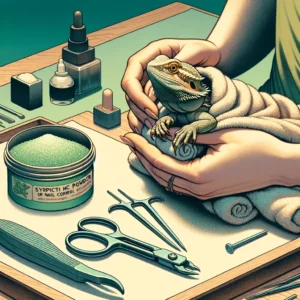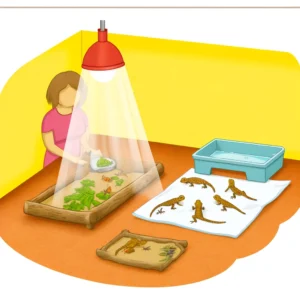Introduction
Keeping a bearded dragon as a pet requires dedication, especially when it comes to maintaining a clean and healthy environment for them. Proper tank cleaning is essential for preventing diseases and ensuring your bearded dragon lives a long, happy life. This article breaks down the tank cleaning process into manageable steps, offering a straightforward guide to help both new and experienced bearded dragon owners.
Pre-Cleaning Preparation
Before diving into the cleaning process, it’s crucial to have all necessary tools and supplies on hand. These include:
- Cleaning gloves: To protect your skin from potential irritants.
- Disinfectant cleaner: Choose a reptile-safe product to avoid harming your pet.
- Scrub brush or sponge: For scrubbing the tank and decorations.
- Handheld vacuum or paper towels: For spot cleaning.
- Separate container: To house your bearded dragon temporarily.
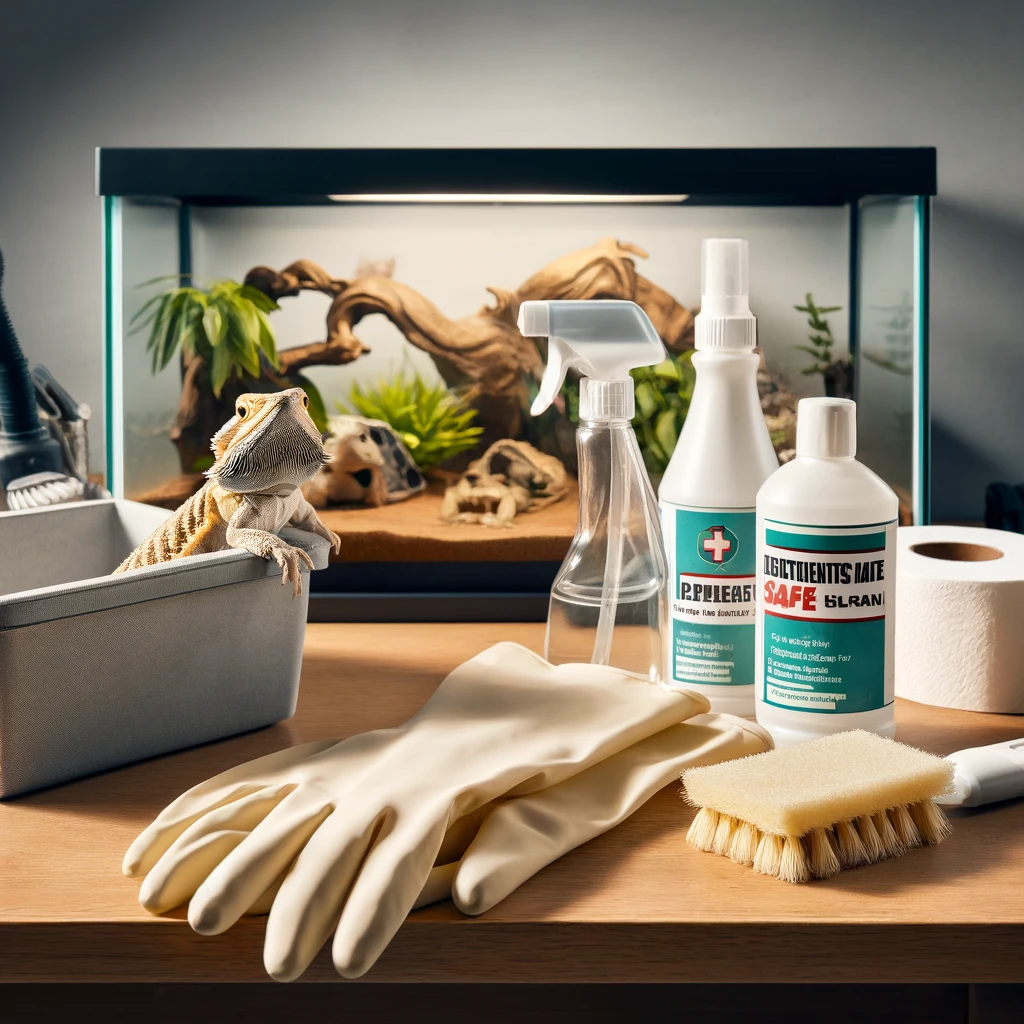
1. Prepare the Area and Gather Supplies
- Supplies Needed: Reptile-safe disinfectant, cleaning gloves, scrub brush or sponge, handheld vacuum or paper towels, and a separate container for your bearded dragon.
- Preparation: Set up a designated cleaning area with all necessary supplies readily accessible.
2. Relocate Your Bearded Dragon
- Temporary Housing: Gently place your bearded dragon into a separate, safe container with ventilation to ensure they are secure while you clean the tank.
3. Remove Tank Accessories
- Decorations and Substrate: Carefully remove all decorations, climbing structures, and the substrate from the tank. If you use a reusable substrate, set it aside for cleaning.
4. Spot Clean and Remove Waste
- Cleaning: Use a handheld vacuum or paper towels to remove any feces, uneaten food, and debris from the tank and accessories.
5. Clean and Disinfect the Tank
- Disinfecting: Spray the inside of the tank with a reptile-safe disinfectant. Allow it to sit for the amount of time recommended by the product instructions.
- Scrubbing: Use a scrub brush or sponge to thoroughly clean the tank walls, floor, and any hard-to-reach areas.
- Rinsing: Rinse the tank several times with water to ensure all disinfectant is removed.
6. Clean Accessories and Decorations
- Soaking: Submerge decorations and accessories in a solution of reptile-safe disinfectant.
- Scrub and Rinse: After soaking, scrub them clean, then rinse thoroughly with water to remove any disinfectant residue.
7. Dry the Tank and Accessories
- Drying: Ensure the tank and all accessories are completely dry before reassembling. You can use clean paper towels to help speed up the process.
8. Replace Substrate and Decorations
- Substrate: Add clean or new substrate to the bottom of the tank.
- Accessories Placement: Return all decorations and accessories to their original places, or take this opportunity to rearrange them for a change of scenery for your bearded dragon.
9. Return Your Bearded Dragon to the Tank
- Careful Handling: Once everything is dry and in place, gently return your bearded dragon to their clean tank.
10. Wash Your Hands
- Hygiene: After the cleaning process, thoroughly wash your hands with soap and water to remove any contaminants.
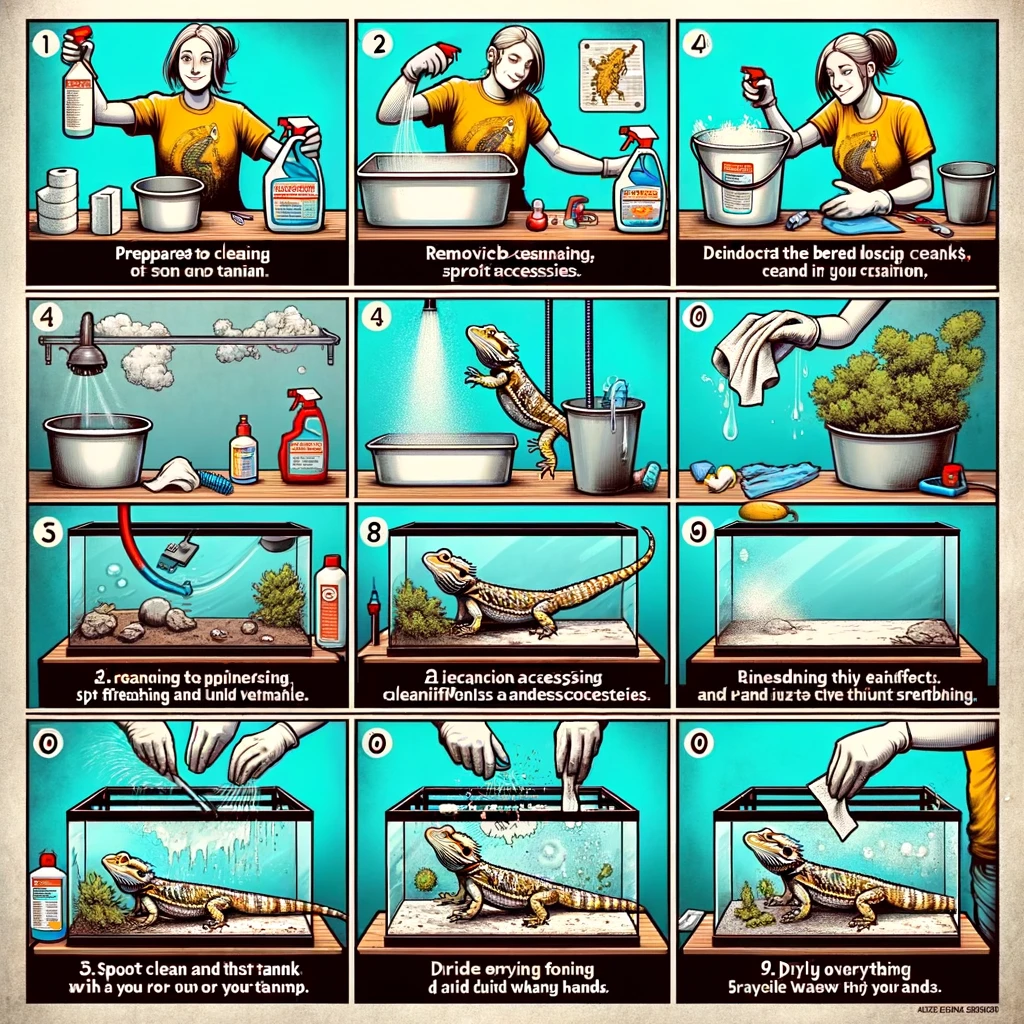
Daily Spot Cleaning
- Remove Waste: Every day, inspect the tank for feces, uneaten food, and other debris. Using a handheld vacuum or paper towels, promptly remove these to prevent the growth of bacteria and mold.
- Water Dish Maintenance: Clean the water dish daily. Dispose of the old water, rinse the dish with hot water, and refill it with fresh, clean water to ensure your bearded dragon stays hydrated with uncontaminated water.
- Check for Odd Smells: A quick sniff test can help identify any unseen issues. Persistent bad odors may indicate a hidden mess or a need for a more thorough cleaning.
Weekly Deep Cleaning
- Relocate Bearded Dragon: Move your pet to a secure, temporary container to prevent stress and ensure their safety during the cleaning process.
- Decoration and Accessory Cleaning: Remove all interior items, including rocks, branches, hides, and any decorative items. Wash them with a reptile-safe disinfectant, scrub away any dirt or waste, rinse thoroughly, and allow to dry completely before returning them to the tank.
- Substrate Change: Depending on your choice of substrate (paper towels, reptile carpet, or sand), either replace it entirely or clean it if reusable. Ensure the substrate is completely dry before placing it back in the tank.
- Tank Scrubbing: With the tank emptied, use a reptile-safe disinfectant to clean all surfaces, including the glass, base, and lid. Thoroughly scrub to remove any residues or buildup, rinse well with water, and dry the tank before reassembling.
- Filter and Equipment Maintenance: If your setup includes a filtration system, take this time to clean the filters. Also, check and clean any heating and lighting fixtures to ensure they are working correctly and safely.
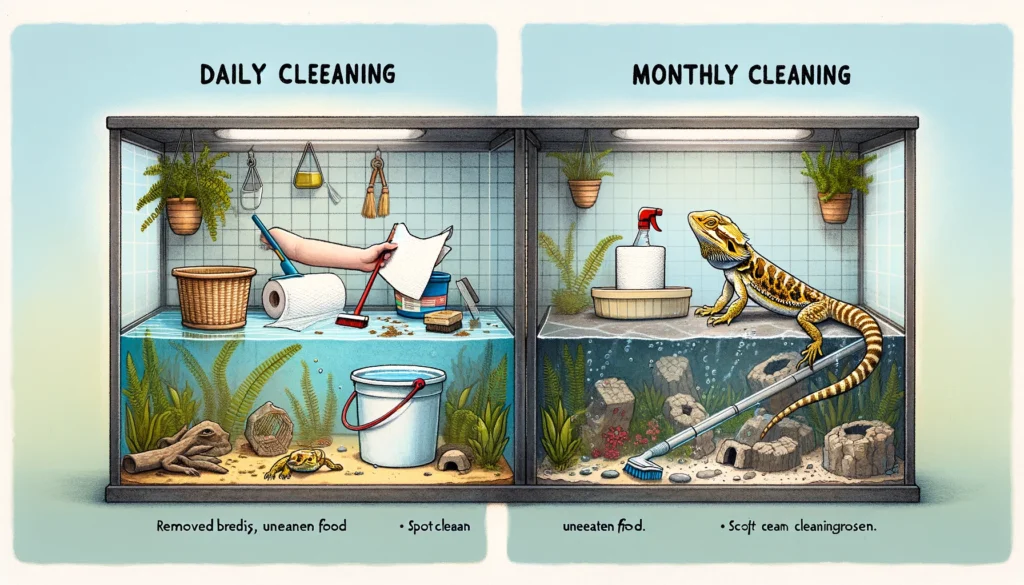
Monthly Health Check
- Inspect Your Bearded Dragon: Look for any signs of health issues, such as lethargy, lack of appetite, discolored skin, or abnormal feces. Early detection of health problems can be crucial for effective treatment.
- Habitat Inspection: Check the condition of the tank and all equipment, including lights, heaters, and thermometers, to ensure they are functioning correctly. This is also a good time to review the tank setup to ensure it meets your bearded dragon’s needs as it grows.
FAQs
How often should I clean my bearded dragon’s tank?
- Spot Clean Daily: Remove feces, uneaten food, and debris every day.
- Deep Clean Weekly: Perform a thorough cleaning of the tank and its decorations once a week.
- Full Substrate Change: Replace or clean the substrate fully during the weekly deep cleaning, or more often if necessary.
Can I use household cleaners for the tank?
- Use Reptile-Safe Cleaners: It’s crucial to use cleaners that are safe for reptiles. Household cleaners may contain chemicals that are harmful to bearded dragons. Look for reptile-safe disinfectants or use a solution of vinegar and water (followed by a thorough rinse) for a natural alternative.
How do I disinfect the tank without harming my bearded dragon?
- Proper Disinfection: After removing your bearded dragon from the tank, apply a reptile-safe disinfectant. Allow the cleaner to sit for the recommended time before thoroughly rinsing the tank with water to remove any chemical residue. Ensure the tank is completely dry before returning your pet.
What substrate is easiest to clean?
- Substrate Choices: Paper towels and reptile carpets are among the easiest to clean and replace. Sand and other loose substrates can be more challenging to keep clean and may require more frequent changes.
How can I minimize stress for my bearded dragon during cleaning?
- Minimize Stress: Keep your bearded dragon in a comfortable and secure temporary enclosure during cleaning. Ensure the temporary habitat is safe and familiar, using a familiar hide or decoration can help reduce stress.
Is it necessary to clean the decorations and rocks?
- Decorations Cleaning: Yes, it’s essential to clean all decorations, rocks, and hides as they can harbor bacteria and parasites. Wash and disinfect these items during your weekly deep cleaning routine.
How do I know if my bearded dragon is stressed by its environment?
- Signs of Stress: Indicators include changes in behavior such as aggression, hiding more than usual, loss of appetite, and changes in fecal matter. Environmental stress can sometimes be alleviated by improving the cleanliness and setup of the tank.
Can I leave my bearded dragon out of its tank while cleaning?
- Supervised Time Out: Yes, you can allow your bearded dragon some supervised time outside its tank in a safe, enclosed space. This can be an excellent opportunity for exercise and interaction, but ensure the room is escape-proof and free from hazards.

Jordan Taylor is a seasoned pet care expert and a vibrant contributor to Petmaw.com. With over a decade of experience in veterinary science, Jordan brings a wealth of knowledge and a deep passion for animals to every article. After earning a degree in Veterinary Medicine from the University of Alaska Anchorage, Jordan spent several years working in a busy veterinary clinic, where they honed their skills in pet nutrition, behavior, and wellness.
Jordan’s love for animals isn’t just professional; it’s a fundamental part of their life. Home is shared with three rescue Sloth, two cats, and a small flock of backyard chickens, each with their own rescue story and special place in Jordan’s heart. This personal connection to animals shines through in Jordan’s writing, making their advice not only expert but also empathetic and practical for pet owners.
At Petmaw.com, Jordan is dedicated to providing pet owners with the latest research, trends, and tips in pet care, from innovative feeding strategies to understanding the subtle signs of pet health issues. Whether you’re a seasoned pet owner or new to the pet parenting world, Jordan’s insights aim to enhance the well-being of pets and deepen the human-animal bond.
In their spare time, Jordan is an avid hiker, often found exploring the trails with their dogs. They also volunteer at local animal shelters, offering their expertise and helping animals in need find forever homes. Jordan’s commitment to animal welfare and passion for sharing knowledge makes them a cherished member of the Petmaw.com family and a trusted guide for our readers.



